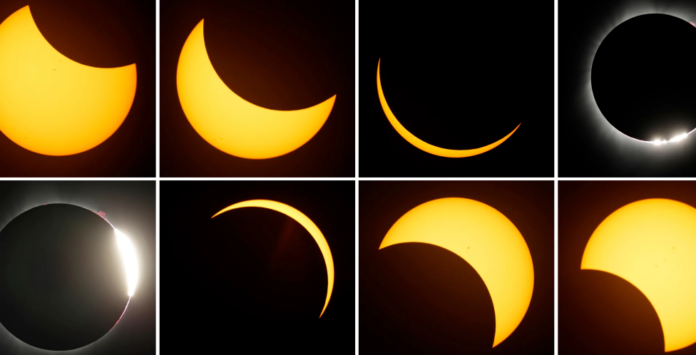On Monday, April 8, 2024, the celestial ballet of the sun, moon and Earth will culminate in one of the grandest cosmic performances ever to grace American soil – a total eclipse of the sun. From the wide open ranchlands of Texas to the rocky shorelines of Maine, a rustic 115-mile wide trail bisecting the United States will experience a breathtaking few minutes of mid-day nightfall.
The main acts in this natural phenomenon star the moon as it ever-so-precisely slips between the Earth and sun, completely obscuring the brilliant solar disk from a narrow terrestrial corridor. As the moon’s umbral shadow races across 14 U.S. states at supersonic speeds, it will allow the sun’s ethereal outer atmosphere – the corona – to emerge from obscurity and put on a dazzling visual spectacle for thoseunie enough to catch the fleeting cosmic concurrence.
This singular event, dramatically dubbed the “Great American Eclipse,” represents one of the bucket-list astronomical experiences of the decade – perhaps of multiple lifetimes for many areas it traverses. From the Mexican border to the Canadian maritime, cities situated along the path of totality are bracing for a monumental influx of visitors as umbraphiles (eclipse chasers) from around the world flock to the narrow line of best seats.
The Elusive Total Eclipse
While partial solar eclipses that only obscure a portion of the sun occur somewhat regularly, total solar eclipses visible from any specific location are among the rarest of planetary alignments. The celestial choreography requires the moon’s orbit to take it directly between the Earth and sun at just the right instance when the lunar disk perfectly covers, but doesn’t overshadow, the sun’s diameter.
On April 8th, this incredible cosmic coincidence will play out in exquisite detail for potentially millions of observers stationed along the path of the moon’s traveling umbra – the zone of total eclipse rushing across the American heartland. Outside this narrow swath of totality, the moon will appear too small to fully overlap the sun, creating a “bite” out of the solar disk known as a partial eclipse visible across a much broader region.
However, astronomy experts caution that there is no safe way to look directly at the partially eclipsed sun without properly certified solar filters or projection methods. The sun’s intense visible and invisible radiation can cause permanent eye damage before one even realizes they’ve looked too long. Only during the brief total phase, when the sun is 100% covered, can observers gaze safely at the sun’s gossamer outer atmosphere – a sight that eclipse chasers dream about and plan years in advance to witness.
“During totality, you’ll see the sun’s corona emerge like a celestial crown around the blackened sun,” explains Dr. Tyler Nordgren, astronomer and eclipse expert. “The atmosphere on the Moon’s edge may show shimmering beads of light, while planets and bright stars suddenly become visible in a twilight sky as the environment around you transforms in truly mesmerizing ways.”
This magical solar maxima will last no more than 4 minutes and 28 seconds at any given location along the path, making it an ultra-rare temporal event as well. Most areas traversed by the eclipse’s transcontinental path have not witnessed totality in over a century, if ever.
The Path Across America
When the eclipse’s first point of totality strikes the U.S. at 1:27 pm CDT along the Mexico border south of Del Rio, Texas, a cosmic shadow race will begin. Over the subsequent 2 hours and 5 minutes, the 71-mile wide umbra will blaze a 2,800-mile arcing trajectory at supersonic speeds toward a final eclipse landfall at West Quoddy Head, Maine around 3:32 pm EDT.
Along this path through America’s heartland, cities large and small are preparing for a monumental surge of celestial tourists and astronomy chasers hoping to plant themselves directly under the moon’s dark umbral shadow cone. The movement of people has been equated to the logistical demands of 50 simultaneous Super Bowl events happening simultaneously across the nation.
“We’re expecting this to be the largest mass travel event in U.S. history for a single occurrence,” says Michael Zeiler of GreatAmericanEclipse.com. “Eclipse chasers are a dedicated group who will go to any lengths necessary to immerse themselves in the universe’s most awe-inspiring spectacle.”
Some of the prime locales expecting large influxes of eager umbraphiles include:
- Austin, TX – Totality at 1:36 pm CDT for 1 min, 53 secs
- Carbondale, IL – 1:59 pm CDT totality lasting 4 mins, 8 secs
- Indianapolis, IN – 3:06 pm EDT with 3 mins, 46 secs of totality
- Cleveland, OH – 3:13 pm EDT eclipsed sun for 3 mins, 50 secs
- Buffalo, NY – Sun 100% eclipsed at 3:18 pm EDT for 3 mins, 45 secs
Regardless of where observers plant themselves along this cosmic corridor on April 8th, they’ll be treated to differing, but uniformly breathtaking views of the total solar eclipse. The sun’s ethereal corona may appear asymmetric, forking out tendrils of plasma millions of miles into space. Or it could take on a more delicate butterfly-like structure, suspended in an inky-black sky allowing bright stars and planets to twinkle into view.
A Rendezvous in the Cosmos
Total eclipses of the sun have punctuated many pivotal moments of human history, captivating cultures dating back to our species’ earliest days of tracking celestial motions. From inspiring Anasazi petroglyphs, to pioneering early experiments into the sun’s atmosphere, to helping confirm Einstein’s theory of general relativity, these rare cosmic dances have expanded our scientific understanding while connecting humanity to the greater universe around us.
For millions of Americans, the Great American Eclipse of 2024 could represent their first and perhaps only chance to intimately experience this profound celestial phenomenon in their lifetimes. The last total solar eclipse visible from the contiguous United States swept across a diagonal path from Oregon to South Carolina on August 21, 2017. And after next year’s eclipse finishes its transcontinental jaunt, the next opportunity for those in the mainland U.S. to glimpse totality won’t come until August 12, 2045, when the moon’s shadow races from Northern California to Florida.
With such infrequent alignments, it’s no surprise the Great American Eclipse is generating unparalleled levels of enthusiasm and anticipation across the scientific, education and stargazing communities. Whether traveling cross-country or stepping into one’s backyard along the path of totality, April 8, 2024 promises to be an astronomical experience that forever alters cosmic perspectives and connections.
“Seeing a total eclipse of the sun is one of the most humbling and life-changing events someone can witness,” reflects Nordgren. “For those precious moments of totality, you realize just how minuscule we are in our vast universe, and yet how fortunate we are to reside on such a quirky little planet that provides us front-row seats to the cosmos’ grandest ballet.”
So as spring blossoms across America in 2024, millions will turn their gaze skyward for Nature’s most dramatic celestial masterpiece. From the Plains to the Appalachians, and everywhere in between, this Great American Eclipse is destined to imprint itself indelibly on our collective memory and consciousness as one of the must-see events of the decade.





















